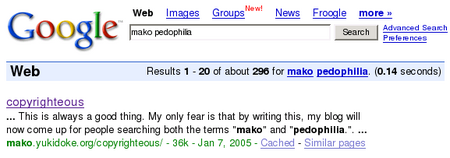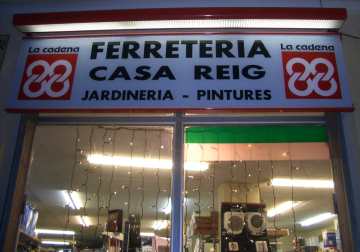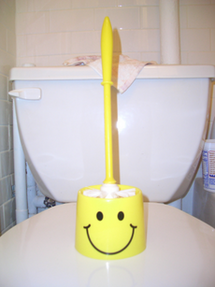Many web-based forms are just online versions of paper forms. I suspect that many of online forms are now being created automatically from their printed predecessors. The fragment of the form below, which I was asked to fill out yesterday, is one reason I think this:
“He Always Ends Up Back At Home Eventually”
Mika’s has a fish. The fish is a betta and, living in an environment steeped in technology and copyright jurisprudence, his name is Betta-Max. Since Betta’s are also called "Fighting Fish" I thought it would be funny if bought my own fish, named it Universal Pictures and put it in an adjacent container. But I haven’t done this yet and that’s not what this entry is about.
On Christmas day, I realized that I had lost Max. Luckily, I found him two days ago and he is now safely returned to the table.
I think this story is only a good one if I don’t say any more than this.
I Asked For It
If you read this recent blog entry, you’ll realize why I’m particularly unhappy about the result of this google search:
My only comfort is that at least I dragged Debian and Ubuntu planets onto the front page with me.
Imagining “Neither Very Much Greater Than Nor Very Much Less Than”
I was pleased to see that my recent post on the interrobang generated a good deal of excitement for this long neglected piece of punctuation. I’ve heard that there will even be a compose key sequence for the interrobang in future version of Debian’s X! It’s inspired me to do another little report from my explorations of Unicode.
I can not claim to be an expert in math(s) and I welcome clarifications and corrections. That said, I find the mathematical symbols in Unicode to be some of the most interesting. I have found these useful in the past when I wanted to concisely express that something is very much greater than (⋙) something else.
Recently, I have been confused by the "neither less-than nor greater-than" (≸) and its companion "neither greater-than nor less-than" (≹) glyphs.
In the past, I have (naively I’m told by people who are better at math than I) eschewed Unicode entirely and used the ASCII equals (=) character every time I wanted to express this relationship. I’m told (although I have yet to meet someone who can give me an example or explain why) that the relationship between numbers need not be equal to, less than, nor greater-than in some forms of math.
I’m willing to accept that. But wouldn’t that also require a "neither greater-than nor less-than nor equal to" symbol? Wouldn’t the "neither greater-than nor less-than" symbol really be implying "neither greater-than nor less-than but possibly equal to or not equal to" which would be something different?
Another character I’m still confused by is the "strictly equivalent to" symbol (≣). I understand =, ≠, ≡, and ≢ but my complexity threshold seems to be breached when the fourth bar is introduced. I also don’t understand why there is not a "not strictly equivalent to" character.
By the definitions I use, ≸ and ≹ seem strictly equivalent to me. Would be it fair to say that ≸ ≣ ≹‽
Not The Mako You’re Looking For
I was pleased to see that my blog now outranks pedophiles (or ‘paedophiles’ as your locale may dictate), for google searches on my name.
This is always a good thing.
My only fear is that by writing this, my blog will now come up for people searching both the terms "mako" and "pedophilia."
My Greatest Talent
I think my greatest talent might be reading and writing emails. I’m not the best I’ve ever seen but when I’m in a zone, I think I can hold my own against some of the better emailers out there.
I think it would be great to show this off in a talent show some time. With my mutt session being projected, I could start out with 1000 emails that are a mix of spam, list mail, irrelevant stuff and highly relevant email and I could sort through these quickly replying to important emails where necessary.
If I had seen someone do this when I was young, I would have been very impressed.
Beano Cuisino
Through exploration prompted by my last blog entry, you may now know that like everything else today, Beano has a website.
Like many other websites, Beano has added a few features to keep folks coming back. I can happily tell you that Beano didn’t settle for some silly Beano-oriented flash game (yikes) but instead decided to build a comprehensive database of foods whose potential for methane production in the human digestive tract are so intense that you’d have to be crazy to eat them without Beano.
At least, that seem to be the idea. Its called Beano Cuisino and it’s absolutely brilliant.
They’ve got all the classics, like baked bean burritos. They’ve also got more adventurous offerings like sweet and sour lentils with egg noodles. You can polish it all off with a chocolate lentil cake
I think that a desire to increase gas production is the only reason anyone would ever eat a chocolate lentil cake.
My younger brothers will love these recipes.
S-methyl 3-(methylthio)thiopropionate
My favorite vegetable is asparagus which is good because it’s very healthy. The only thing I would change about asparagus is the way that it makes the urine of the people who eat it stink. Curious about the phenomena, I found an article on Occurrence of S-methyl thioesters in urines of humans after they have eaten asparagus that had been published in an issue of Science in 1975. Its author said:
Gas chromatography-mass spectrometry was used to determine the odor-causing agent (or agents) present in the urines of humans after they have eaten asparagus. S-Methyl thioacrylate and S-methyl 3-(methylthio)thiopropionate were identified from methylene chloride extracts of such urines and appear to be the odor-causing compounds. Methanethiol, the previously reported odor-causing agent, was not detected in these methylene chloride extracts.
It certainly sounds like S-Methyl thioacrylate and S-methyl 3-(methylthio)thiopropionate are the culprits. I think the next step important step is to produce a sort of asparagus-urine-stink prophylactic. Kind of like Beano.
I’m Mako and I’m an Addict
Every time that people organize to sign keys around Jeff Waugh he tries to ridicule the keysigning phenomenon by likening the process to intravenous heroin use. He will say something like, "I’d love to sign keys guys but I don’t have my needle, and I can’t find a good vein, and I’d have to go back to my room to get my Bunsen burner."
I think this characterization is grossly misinformed.
Few heroin addicts would ever bother to use a Bunsen burner.
Open Source Is Dead
In the last year, I have heard a couple very smart people involved in the free software movement call open source dead or dying. This is clearly intended as a provocative statement — the nature of the critique is not immediately apparent — but I think that it might be true.
Most people reading this will know that open source is a movement started to distance the software created by the free software movement from the movement’s people and ideals. Open source exists as an answer to the fear that people who wear suits will run away every time they hear the word freedom. Open source folks argue that you can sell free software by emphasizing the practical benefits and wrapping the code in new, more business-friendly term.
For a period of time, open source seemed spectacularly successful. The people in suits latched onto the idea and thrust the movement into the spotlight. Open source could be found in the business sections of the newspaper, and the NASDAQ’s swelling list of explosive tech IPOs in the late 1990s.
With Raymond’s "The Cathedral and the Bazaar" freshly thumbed on their bedside tables, executives and engineers alike stuck the GPL and the source code for their latest development project into a neat little package and onto a website. They sat back waited for bugs to start disappearing. They were usually disappointed.
There are many practical benefits to open source, but with time and with the sense of self-reevaluation that the bursting of the dot-com bubble brought, many people looked more closely at open source’s claim that their software was, in all situations, inherently better than proprietary software. Open Source is inherently better — but only for some definitions of better. For those whose definition of better involves the immediate and constant growth of a company’s stock price, there may be reasons to be less uncritically optimistic than we all were in 1999.
Since the peak of the bubble, we’ve seen many companies abandon their faith in the gospel of open source. Linuxcare has a new name an a new business model selling proprietary software. Red Hat is betting on Red Hat Enterprise Linux which, while still embracing the letter and licenses of open source, seems to depend more on the restrictive power of trademark law than Eric Raymond’s word and the inherent power of the community. In some situations, the open bug tracking systems from the boom have shriveled and disappeared. The GPL is still in effect, but development has moved back inside the shops.
But my story so far is one of ideology, not of terminology, and not of the software in question.
While the ideology of open source seems to be waning in popularity, the term "open source" is growing in strength. More importantly, the software itself is bigger than ever and growing quickly. In Spain, regional governments are embracing "open source" and software libre. In Munich, in Brazil, and in non-profit organizations and schools around the globe, "open source" is a familiar phrase.
People haven’t stopped talking about and deploying open source, but the people who do this today are not the people who bought stock in VA Linux’s IPO. Ironically, those talking about open source today increasingly use the term to refer to the ideals and ideas of the free software movement which the open source initiative sought to deemphasize. When people say "open source," they are increasingly often speaking about "free software."
A handful of examples can illustrate this point:
- Ubuntu, which uses both the terms open source and free software, paraphrases important parts of the free software Definition (FSD) in their philosophy page — so even when they use the term "open source", they are talking about freedom.
- David Turner, licensing guru for the Free Software Foundation, has told me that he has seen the term open source defined verbatim as the FSD.
- Sergio Amadeu, technology czar for the Brazilian presidency sued for libel by Microsoft, routinely talks about the essential role of freedom in software.
In these examples and in non-profit organizations and in groups of computer users from across the developing world, people are as much driven by their desire for software freedom and institutional independence as they are by their desire for a cheap OS and an alternative to DRM. People are increasingly often talking about free software — even when they are using the words "open source".
Richard Stallman throws a fit every time he hears the word "open source" used in reference to his work. What he should be angry about is the confusion of the goals of the free software movement with the goals of open source. Stallman doesn’t seem to see that the term open source’s relationship to the two sets of goals is increasingly confused.
I will continue to talk about free software because I like disambiguating the term and explaining why I think that software and information freedom is a good thing. But I’m increasingly skeptical that the term "free software" can win. While the label "open source" will triumph, the concept will not. It’s not my ideal world but I think I will be happy.
Fringe Inference
Last night, I took a risk and gave myself a haircut. I also bought a hat.
Many people might think that they could easy infer a causal relationship from this information but they would be wrong. My haircut is great and the fact that the hat hides it is merely part of the price I pay to stay warm.
Today’s Sale: ‘Mongoose Madness!’
With it’s Latin roots (ferrum meaning iron and everything), I understand why in Catalan (and Spanish), a hardware store is called a ferreteria:
What I don’t understand is what you call a store that sells ferrets.
Telecom
My friend is applying to Tisch’s Interactive Telecommunication Program. He is very interested in the program but not as wild about the "tele" bit; Just how far away do the people he’s trying to communicate with need to be? Would across the room work? I suggested that perhaps if his communication were "far out" (in the 1960’s sense of the word), that might qualify as "tele".
I also suggested that a fun way to begin his interview might be to say, "I’m interested in your program but I live in New York City and it seems kind of silly for me to telecommute." The faculty doing the interview would either thing he as very clever — or wouldn’t.
Even The Mightiest Fall
I was pretty confident that Mika and I had the cutest toilet bowl cleaner (see Figure 1).
I’m sad to say that after a visit to Jordi Mallach’s bathroom in Valencia last week, I am reconsidering this (see Figure 2).
|
Figure 1 |
Figure 2 |
Listen Up‼
I’ve heard folks on mailing lists argue (only partially in jest) that multiple punctuation points, and in particular multiple exclamation points, are a sure sign of a brain damage.
Recently I’ve been wondering what to make of folks who use the interrobang (‽) and other Unicode characters that combine multiple pieces of punctuation into a single glyph (like ⁉, ⁈, and of course ‼). Do these count as one punctuation point or a single new hybrid mark? What does using ending a sentence with such a mark say about the author⁇




